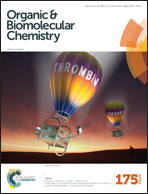Theoretical studies on CuCl-catalyzed C–H activation/C–O coupling reactions: oxidant and catalyst effects†
Abstract
Copper-complex catalyzed coupling reactions have been widely applied in the production of many important organic moieties from a synthetic perspective. In this work, a series of density functional theory (DFT) calculations, employing the B3LYP + IDSCRF/DZVP method, have been performed for a typical CuCl-catalyzed C–O cross-coupling reaction. The novel reaction mechanism was reported as four successive processes: oxidative radical generation (ORG) or oxidative addition (OA), hydrogen abstraction (HA), C–H activation/reductive elimination, and separation of product and recycling of catalyst (SP & RC). Our calculations provided a deep understanding on the dissimilar chemical activities associated with varying the oxidants used; detailed energy profile analyses suggested that the first oxidation process could proceed via either of the two competing channels (ORG and OA mechanisms) which is the basis to explain the different experimental yields. In addition, our molecular modelling gave theoretical evidence that Cu(II) → Cu(I) reduction by solvent DMF (and a water molecule) might serve as a preliminary step to produce some more active Cu(I) species that could subsequently be oxidized into Cu(III) favorably. In contrast, the Cu(II) → Cu(III) direct pathway was estimated to be prohibited from thermodynamics. All the calculation results in this work are parallel with the experimental observations.


 Please wait while we load your content...
Please wait while we load your content...